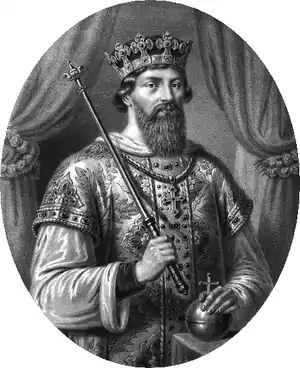| Millennium: | 2nd millennium |
|---|---|
| Centuries: | |
| Decades: | |
| Years: |
| 1039 by topic |
|---|
| Leaders |
|
| Birth and death categories |
| Births – Deaths |
| Establishments and disestablishments categories |
| Establishments – Disestablishments |
| Gregorian calendar | 1039 MXXXIX |
| Ab urbe condita | 1792 |
| Armenian calendar | 488 ԹՎ ՆՁԸ |
| Assyrian calendar | 5789 |
| Balinese saka calendar | 960–961 |
| Bengali calendar | 446 |
| Berber calendar | 1989 |
| English Regnal year | N/A |
| Buddhist calendar | 1583 |
| Burmese calendar | 401 |
| Byzantine calendar | 6547–6548 |
| Chinese calendar | 戊寅年 (Earth Tiger) 3736 or 3529 — to — 己卯年 (Earth Rabbit) 3737 or 3530 |
| Coptic calendar | 755–756 |
| Discordian calendar | 2205 |
| Ethiopian calendar | 1031–1032 |
| Hebrew calendar | 4799–4800 |
| Hindu calendars | |
| - Vikram Samvat | 1095–1096 |
| - Shaka Samvat | 960–961 |
| - Kali Yuga | 4139–4140 |
| Holocene calendar | 11039 |
| Igbo calendar | 39–40 |
| Iranian calendar | 417–418 |
| Islamic calendar | 430–431 |
| Japanese calendar | Chōryaku 3 (長暦3年) |
| Javanese calendar | 942–943 |
| Julian calendar | 1039 MXXXIX |
| Korean calendar | 3372 |
| Minguo calendar | 873 before ROC 民前873年 |
| Nanakshahi calendar | −429 |
| Seleucid era | 1350/1351 AG |
| Thai solar calendar | 1581–1582 |
| Tibetan calendar | 阳土虎年 (male Earth-Tiger) 1165 or 784 or 12 — to — 阴土兔年 (female Earth-Rabbit) 1166 or 785 or 13 |

Casimir I (the Restorer) (1016–1058)
Year 1039 (MXXXIX) was a common year starting on Monday (link will display the full calendar) of the Julian calendar.
Events
By place
Europe
- June 4 – Emperor Conrad II (the Elder) dies of gout in Utrecht after a 12-year reign. He is succeeded by his 21-year-old son, Henry III (the Black), who also becomes king of Italy and Burgundy.
- Duke Casimir I (the Restorer) returns to Poland, and makes great efforts to rebuild the war-ruined country. He establishes his residence at Kraków (which becomes Poland's capital until 1596).[1]
By topic
Religion
- The Abbey of Bec is founded, located in Le Bec-Hellouin, Normandy (modern France).[2]
Births
- Helibo, Chinese nobleman and chieftain (d. 1092)
- Minamoto no Yoshiie, Japanese samurai (d. 1106)
- Robert de Stafford, Norman nobleman (approximate date)
- Sancho IV, king of Pamplona (approximate date)
- Su Zhe, Chinese politician and historian (d. 1112)
- Vseslav of Polotsk, Kievan prince (approximate date)
Deaths
- March 10 – Odo (or Eudes), French nobleman
- April 16 – William III, count of Weimar and Eichsfeld
- May 27 – Dirk III (or Theodoric), count of Holland
- June 4 – Conrad II (the Elder), Holy Roman Emperor[3]
- July 20 – Conrad II (the Younger), duke of Carinthia
- September 19 – Fujiwara no Genshi, empress of Japan (b. 1016)
- November 4 – Hugh of Chalon, French bishop
- November 29 – Adalbero, German nobleman
- Abu Nasr Mushkan, Persian statesman (or 1040)
- Iago ab Idwal ap Meurig, prince of Gwynedd
- Nathar Shah, Tamil mystic and preacher (b. 969)
- Regimbald, German abbot and bishop
- Reginar V (or Régnier), French nobleman
- Sophia I, German princess and abbess (b. 975)[4]
- Unsuri, Persian poet and writer (or 1040)
References
- ↑ Richard Brzezinski (1995). History of Poland: Old Poland – The Piast Dynasty, p. 18. ISBN 83-7212-019-6.
- ↑ Constable, Giles (2008). Three Treatises From Bec on the Nature of Monastic Life. University of Toronto Press. p. 28. ISBN 9781442691629.
- ↑ "Conrad II - Holy Roman emperor". Encyclopedia Britannica. Retrieved April 8, 2018.
- ↑ McGrath, Alister E. (2013). Christian History: An Introduction. John Wiley & Sons. p. 104. ISBN 9781118337790.
This article is issued from Wikipedia. The text is licensed under Creative Commons - Attribution - Sharealike. Additional terms may apply for the media files.